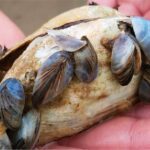Description:
Few lakes have been as well studied as Douglas Lake in northwest Cheboygan County. Home of the University of Michigan Biological Station (UMBS), Douglas Lake has seen its fair share of Secchi discs, thermometers, graduate students, and stunning research publications. The lake has taught and inspired a multitude of students on subjects that range from limnology to ethnobotany.
With over 3,700 acres of surface area, Douglas Lake is ranked the 28th largest lake in Michigan. After the last glaciers retreated some 14,000 years ago, a scattering of enormous ice chunk remnants formed the lake’s seven distinct basins. The deep basins are separated by shallow shoals of less than 15 feet of depth, most of which are heavily vegetated with a diverse assemblage of aquatic plants. The deep basins, the deepest of which reaches 80 feet, contain little to no vegetation. The Biological Station property includes the entire eastern lake shoreline as well as a portion of the north shore and much of the southern shore. The remainder, including Pells Island, is largely privately owned.
Water flows into Douglas Lake from a handful of small creeks, the largest being Bessey Creek on the west end of the north shore and Beavertail Creek in the northeast corner of the lake. Water flows out of Douglas Lake in the southwest corner, forming the East Branch of the Maple River. The high quality water flowing out of Douglas Lake contributes to an expansive network of lakes and streams called the Inland Water Route, which is ecologically and economically important due to recreational use, transportation, and the diverse and healthy aquatic ecosystems. The Maple River empties into Burt Lake and continues onward through the Inland Water Route until flowing into Lake Huron at the City of Cheboygan. The endangered Hungerford’s Crawling Water Beetle is found in the East Branch of the Maple River.
Monitoring and Research:
Douglas Lake is monitored every three years through the Watershed Council’s Comprehensive Water Quality Monitoring (CWQM) Program for dissolved oxygen, specific conductivity, pH, nitrate-nitrogen, total nitrogen, total phosphorus, and chloride levels.
Water transparency, chlorophyll-a, and water temperature are also monitored in Douglas Lake each summer by volunteers as part of the Watershed Council’s Volunteer Lake Monitoring (VLM) Program.
Shore surveys were conducted on Douglas Lake by the Watershed Council in 1998 and 2002.
In 2012, a UMBS limnology class worked with the Watershed Council to perform an in-depth survey of aquatic plant populations in the lake.
Shoreline Survey:
Douglas Lake Shoreline Survey 2024
Project Summary In the spring of 2024, Tip of the Mitt Watershed Council (hereafter referred to as the Watershed Council) contracted with Douglas Lake Improvement Association (hereafter referred to as DLIA) to conduct a shoreline survey on Douglas Lake in the summer of 2024. This shoreline survey project is also
Additional Resources:
See additional resources on our Aquavist page.
View an interactive map of Douglas Lake, including public access sites, at Michigan Fishweb.
A wide variety of maps for this area are available online at the Michigan Natural Features Inventory (MNFI) Data Resources page.
The purpose of the Douglas Lake Improvement Association is to preserve, protect and improve the quality of Douglas Lake and its environs and the quality of life of its residential community. Learn more.



